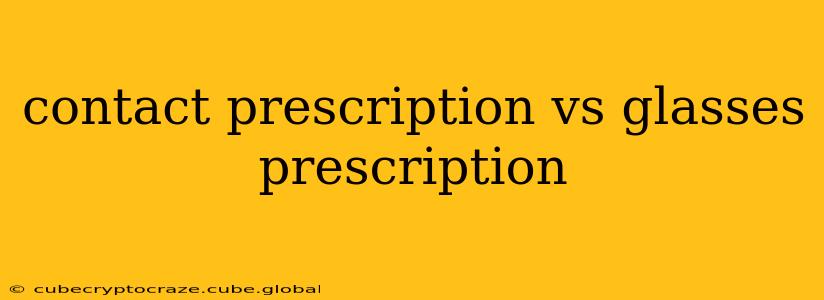Contact Prescription vs. Glasses Prescription: Understanding the Differences
Choosing between contact lenses and glasses often comes down to personal preference and lifestyle. However, a crucial factor to consider is that your prescription for contacts and glasses will likely differ, even if only slightly. This article will delve into the nuances of these prescriptions and why they aren't interchangeable.
What's the Difference?
The primary difference lies in how the lenses sit in relation to your eye. Glasses sit approximately 12-14mm away from the cornea (the front surface of your eye), while contact lenses rest directly on the cornea. This distance significantly impacts how the lens refracts (bends) light to focus it properly on your retina. Because of this difference in location, the power of the lens needed to achieve clear vision is different.
Key Differences Explained:
-
Lens Power: Contact lens prescriptions typically have a slightly different power (sphere and cylinder) than glasses prescriptions. This adjustment compensates for the distance between the eye and the lens. Your eye doctor will make these calculations during your eye exam.
-
Vertex Distance: This is the critical factor differentiating the two prescriptions. It represents the distance between the back surface of the lens (whether glasses or contacts) and the front of the cornea. Glasses have a significant vertex distance, while contacts have virtually zero vertex distance. This difference necessitates the altered prescription values.
-
Other Factors: Beyond the vertex distance, other factors can influence the prescription, including the type of contact lenses (soft or rigid gas permeable) and the specific design of the lens itself.
H2: How does my eye doctor determine my contact lens prescription?
Your eye doctor performs a comprehensive eye exam, including a refraction, to determine your best corrected vision. For contact lenses, they’ll take into account the vertex distance (as mentioned above) and will often perform a fitting to ensure proper lens placement and comfort. They use specialized equipment and techniques designed specifically for contact lens fitting. They may also consider factors like the curvature of your cornea and the thickness of your tear film. This process is more involved than simply converting your glasses prescription.
H2: Can I just use my glasses prescription for contacts?
No, you absolutely should not use your glasses prescription for contact lenses. Attempting to do so can lead to blurry vision, eye strain, discomfort, and even potential damage to your eyes. Always consult your eye doctor for a proper contact lens fitting and prescription.
H2: What if my glasses prescription is recent, and I need contacts?
Even if your glasses prescription is very recent, you still need a separate contact lens examination and prescription. The variations mentioned previously necessitate a tailored prescription for contact lenses.
H2: How often should I get my contact lens prescription updated?
Just like glasses prescriptions, contact lens prescriptions need regular updates. The frequency depends on several factors, including your age, eye health, and the stability of your prescription. Typically, annual eye exams are recommended for contact lens wearers.
H2: What if I experience discomfort with my contact lenses?
If you experience any discomfort, such as blurry vision, redness, irritation, or dryness, contact your eye doctor immediately. Do not attempt to self-diagnose or adjust your lenses without professional guidance.
Conclusion:
Your glasses and contact lens prescriptions are not interchangeable. The difference in lens-to-eye distance necessitates unique prescriptions for optimal vision and eye health. Always consult your eye doctor for a proper fitting and prescription for both glasses and contact lenses. Your eye health is paramount, and a qualified professional can ensure you receive the correct prescription for your visual needs and comfort.
